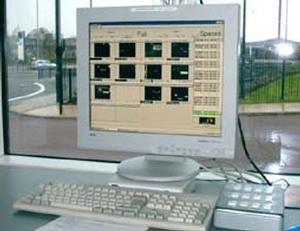Security and access control are generally designed as an integrated package to give a user-friendly, highly secure system. The range of possible functions is constantly expanding and readily encompasses clocking-in, maintaining an inventory of everyone on-site, controlling access in multi-tenanted buildings, and restricting access to secure areas. Systems may comprise a wide range of components including: closed circuit television (cctv) – analogue, digital or hybrid; passive infrared detectors (pirs); door contacts and reed switches; proximity cards and readers; smart cards as well as biometrics – fingerprint, handprint or iris recognition; automatic number plate recognition (anpr) and vehicle control in the form of booms/barriers.
The component parts link together to provide responses to alarms and events, recording images and storing transactions as required.
Closed circuit television
CCTV cameras are located for maximum coverage, and each camera should be covered by another if a malicious attack is likely. Resolution and light conditions must be carefully considered, and many models offer twin-chip or switchable features so that a single camera can produce high-resolution colour images in good light, and acceptable quality black and white images in poor light.
Conventional pan, tilt and zoom cameras are specified for particular applications but domes are generally more cost-effective and offer increasingly superior performance, being relatively discreet, with better weather protection and lighter mechanisms.
The market for video-over-internet protocol solutions (see figure 1) is growing as more clients and designers recognise the potential benefits, and security applications have been among the first to develop. By using the client's new or existing internet protocol network it is possible to transmit video pictures, access control signals and two-way audio simultaneously with data communications, thereby achieving a saving of typically 15% of the cost of installing a traditional analogue security system with its own dedicated network. Internet protocol-based systems offer inherent flexibility for relocating cameras or creating additional control centres, since all components are addressable over the network. In a similar way to traditional systems, individual cameras may be preset or manually controlled using a three-axis joystick from the pc controller/viewer or from a remote internet protocol keyboard. Analogue systems can also be readily integrated by using encoders and decoders (codecs).
On analogue systems, the cameras are linked via coaxial cable to a colour duplex multiplexer. This unit encodes all the camera images for recording by a single time lapse video recorder. The duplex feature allows several images to be presented on one monitor for security personnel. A matrix controller is used to pan, tilt and zoom any individual camera, and pre-set positions may be entered (via software) to respond to particular events, eg a visitor arriving at an access control barrier. An event monitor is normally provided for viewing a single selected image.
Access and alarm control
Computer-based, on-line access systems providing high security access control and alarm monitoring may be specified to stand-alone or be integrated with the client's internet protocol network where appropriate. Control of access to and within buildings by people and vehicles is becoming increasingly important and several technologies have emerged recently to offer viable and innovative high-security solutions, in addition to the familiar proximity cards, keys and tags.
One technology to emerge is biometric systems. Fingerprint or handprint readers may be used alone or in combination with a smart card to ensure that only one person can use it. Biometric templates may be stored in two ways; either within a central database, or alternatively on a smart card. The smart card solution is faster and more convenient because it provides one to one verification at the door, between the reader and the card. Database storage systems work on a one to many matching principle, which is slower and limited in terms of the number of possible templates stored. Other biometric technologies include iris, retina, face and voice recognition; in each case, the template is established and converted into a mathematical algorithm for storage on the smart card or database.
Automatic number plate reading (anpr) offers a powerful and flexible vehicle logging and image database management system for sophisticated car park management and high security campuses and sites. An anpr camera is mounted to monitor traffic in each lane and the number plate of each passing vehicle is logged by proprietary software. Registration numbers are then looked up in a database and relevant information displayed, as well as taking a range of automatic actions. This could include the driver's name, photograph, vehicle make/model etc, plus specific instructions – check pass, open barrier automatically or change an led display to give the driver instructions etc. Further software allows rapid searching based on full or partial number plates, or time and date ranges so that it is easy to establish vehicle arrival and departure times and to carry out various types of analysis.
Downloads
Figure 1 : Video over internet protocol – analogue integration
Other, Size 0 kb
Source
ÐÇ¿Õ´«Ã½ Sustainable Design
Postscript
Acknowledgements: Mott Green Wall would like to thank the following for their assistance in preparing this cost model. Reliance High-Tech (www.relitech.co.uk), CitySync (www.citysync.co.uk) and HID Corporation (www.HIDCorp.com).


















No comments yet